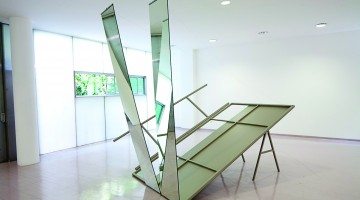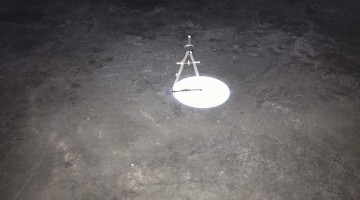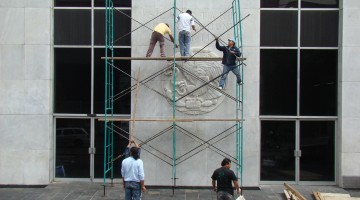Read the English version of this article.
Soy Extraterrestre Entrevista Con John Z. Komurki
¿Por qué la Ciudad de México?
Soy uruguaya. Allá estudié y luego me fui con una beca a Córdoba, España, y estuve casi un año ahí. Una vez que salí de mi país, no volví. Punto. Después de eso pasé una temporada en Nueva York, trabajando con otros artistas, y empecé a formar lazos con la ciudad: me gusta, o me gustaría, considerarme una artista americana, con vínculos en todo el continente, independientemente de la cultura en la que viva. Ahora bien, sí había un motivo personal que me trajo a la Ciudad de México, pero mi decisión de venir y quedarme va más allá de eso. México me parece un lugar idóneamente situado, geográfica y culturalmente, para observar y participar en los flujos culturales que definen las Américas. Además, es una ciudad muy permeable, muy generosa, muy acogedora. Aquí me siento en casa.
¿Cómo se ve la Ciudad de México reflejada en tu arte?
Cursé el programa de SOMA y ahí conocí gente muy linda, amigos y tutores con los que charlar era muy productivo, y sin duda, cambió mi perspectiva respecto a mi trabajo. Siento que hay un antes y un después. Y en lo cotidiano, creo que la ciudad influye de una manera u otra –la calle, el ritmo, los materiales. Hay cosas que no dejan de llamarme la atención. Espero nunca acostumbrarme del todo al paisaje de la Ciudad de México.
Ser extranjera es interesante, porque te da la posibilidad de ver las cosas desde dentro y fuera a la vez. A veces soy extraterrestre. Me pasa igual con el idioma: todos hablamos español, pero a veces tengo la sensación de que soy aún más extranjera por el hecho de hablar el mismo idioma. Y sin duda esta experiencia se ha reflejado en mi arte. Trabajo mucho sobre cuestiones de interioridad/exterioridad, sobre el punto de vista que cada uno tiene de la obra. A veces no sé si lo que hago son fotos de objetos, si la foto es un mero registro: en pocas palabras, cuál es el formato que se le da.
¿En qué proyectos te has involucrado aquí en la ciudad?
Este año participé en Salón ACME No. 2. Se trata de una iniciativa de artistas que organizan exposiciones: no hay limitantes de edad, lugar o lo que sea. Coincide con Zona Maco y la intención es dar una visión un tanto más fresca de lo que podría haber en la feria. Allí ex- puse una instalación que se llama 4,370,005.6 km, que es la circunferencia del sol: es parte de la serie de trabajos entorno al dibujo en el tiempo y de cómo una instalación muy concreta puede remitir a un dibujo abstracto. Pero no en el sentido moderno de “abstracto”, sino de lo que no podemos abarcar –por ejemplo, un kilómetro o la frontera de un país, conceptos esencialmente imaginarios que a la vez tienen una realidad física.
También formé parte de la exposición de SOMA Demasiado futuro, en el Centro Cultural de España en México. Una de la piezas que expuse allí se llama Long 99oW, que también se trata de una especie de dibujo imaginario: el título hace referencia al meridiano que pasa por el centro histórico de la ciudad. Se trata de una especie de péndulo que en la Ciudad de México se vuelve un objeto inestable, movedizo y no tan preciso. Pierde la cualidad de precisión que un péndulo, precisamente, debería tener.
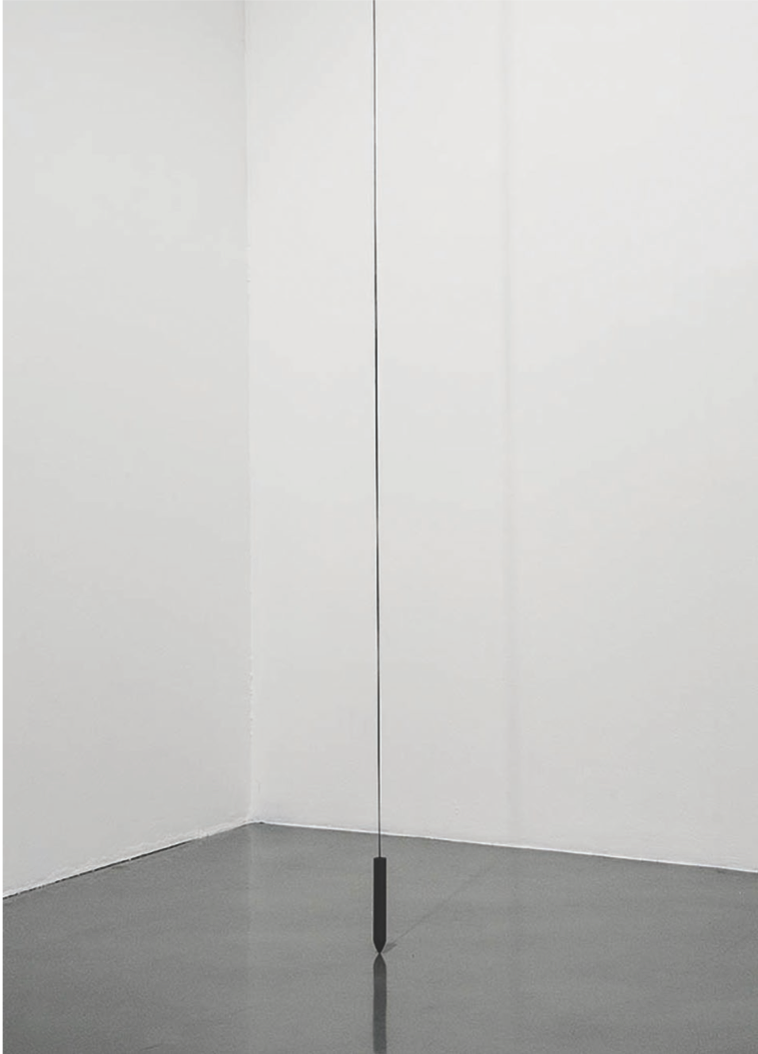
Ana Bidart, Long 99oW, 2014. Graphite rod, string, light and shadow. Dimen- sions variable. Courtesy of the artist.
¿Cuáles son algunos de los artistas y espacios que te han impactado?
Desde antes de llegar, México era siempre un punto de referencia importante para mí. De artistas, me gusta mucho el trabajo de Fernando Ortega y de Iñaki Bonillas, con quien trabajé en un proyecto que se llama Words and Photos. Me gusta que haya espacios como Kurimanzutto, que son enormes y tienen presencia a nivel global, hasta lugarcitos como Lulu o Bikini Wax, que son espacios que funcionan en la casa de alguien. En estos lugares es donde se encuentra mucho del arte más interesante que se está produciendo en la Ciudad de México y, diría yo, en Latinoamérica. Estos lugares también activan la comunidad del arte: se reúne mucha gente y son más amigables para generar lazos, charlas, amistades. Eso se me hace que es muy defeño, comparado con Estados Unidos, por ejemplo, donde a veces es muy difícil penetrar la escena: si alguien llega un fin de semana a la Ciudad de México y va a tres o cuatro de estos lugares, definitivamente va a conocer a gente que está haciendo cosas.
¿En qué estás trabajando ahorita?
Por un lado, estoy trabajando en unas pinturas que surgieron a partir de un proyecto concreto que hice para una feria, que era casi autobiográfico. Tiene que ver con mi trabajo como asistente de artistas: ese trabajo que en principio no se ve, todo lo que hay detrás de una exposición que, por definición, se queda invisible. Lo interesante para mí es que hasta ahora nunca había pintado, lo cual es un poco al revés, ya que mucha gente empieza pintando en la escuela y luego se enfoca en otras cosas. Entonces sí estoy en un proceso de pensar la pintura como lo venía haciendo con el espacio, con los objetos. Estoy también trabajando en una instalación para un exposición personal el año que viene. ¡Más detalles muy pronto!
¿Hay ciertas temáticas específicamente latinoamericanas que se manifiestan en tu obra?
Uno no lo hace pensando en la historia latinoamericana –bueno, yo no– pero es verdad que luego se encuentran coincidencias o pun- tos en común. Hay ciertas referencias, como por ejemplo Hélio Oiticica: él y toda su generación marcaron mucho a Latinoamérica. Fue muy político, sí, pero tenía también una visión muy contemporánea que sigue vigente hoy día, que puede ser una actitud más que una estética. Una postura crítica sobre lo que podría implicar ser un artista latinoamericano, la cual sin duda ha dejado su huella en mi propia práctica artística.
Personalmente, también me he interesado mucho en el movimiento italiano arte povera. Ciertos aspectos de la realidad socio-económica actual en Latinoamérica pueden tener algo que ver con ese momento en la historia italiana. Por lo tanto, yo creo que hay algunas propuestas que se pueden reapropiar y aplicar aquí, ahora. Claro, siempre hay un circulo: uno está siempre trabajando en referencia a la historia del arte, pero algunas influencias a veces están más cerca, son más relevantes.
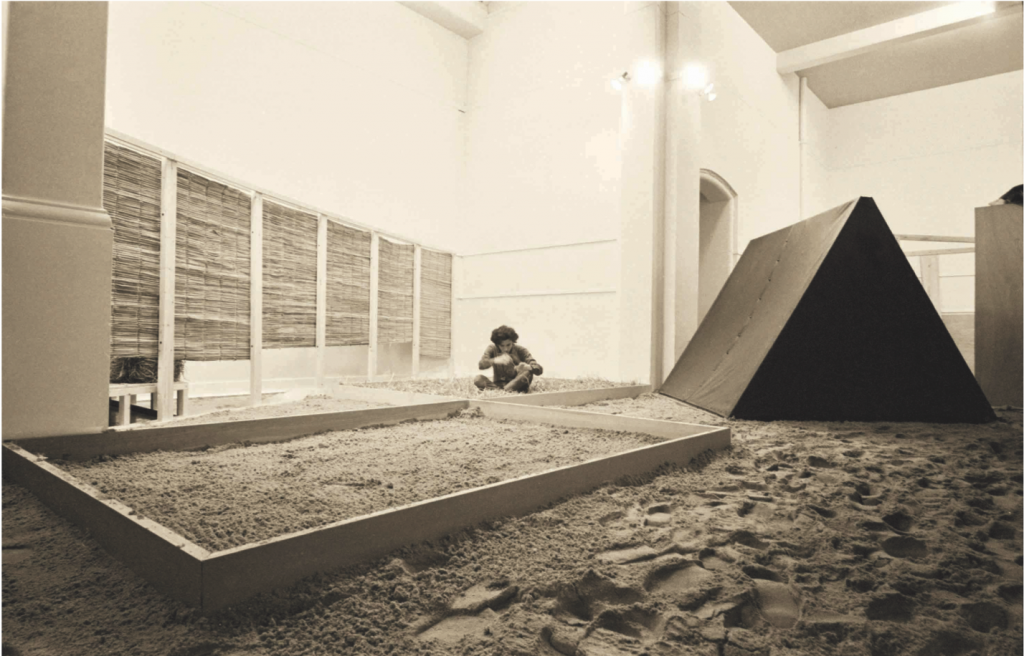
Hélio Oiticica, Eden, 1969. Installation view, Whitechapel Art Gallery, London, 1969. © Projeto Hélio Oiticica, Rio de Janeiro. Courtesy of the artist.
I Am An Extraterrestrial Interview With John Z. Komurki
Why Mexico City?
I’m Uruguayan. I studied there and then I went on a scholarship to Cordoba, Spain, and I was there for almost a year. Once I left my country, I didn’t go back. Full stop. After that I was in New York for a while, working with other artists, and began to forge connections with the city. I like, or would like, to consider myself an American artist, with links across the whole continent, independently of the culture in which I live. Now, there was a personal reason behind my moving to Mexico City, but my decision to come and to stay here goes beyond that. Mexico seems to me to be ideally located, geographically and culturally, to observe and participate in the cultural currents that define the Americas. What’s more, it is a very permeable city, very gen- erous, very welcoming. I feel at home here.
How is Mexico City reflected in your art?
I studied at SOMA, and there I met great people, friends, and tu- tors with whom I had productive dialogue, and this without a doubt changed my perspective on my work. I do feel that there is a before and an after. And in a day-to-day sense, I feel like the city does have an influence, one way or the other—the street, the rhythm, the materials. There are things that never fail to catch my eye. I hope I never become totally accustomed to the Mexico City landscape.
Being a foreigner is interesting, because it gives you a chance to see things from inside and outside at the same time. Sometimes I’m an extraterrestrial. The same thing happens to me with the language: we all speak Spanish, but sometimes I have the feeling that I am even more foreign because I speak the same language. And without a doubt this experience has been reflected in my art. I work a lot on questions of interiority/exteriority, on the point of view one has of the work. Sometimes I don’t know if what I make are photos of objects, or if the photo is only a record: which format you give it, in short.
What projects have you been involved in here in the city?
This year I had work in Salón ACME No. 2. This is an initiative of artists that organize shows: there are no limits based on age, nationality, or whatever. It’s at the same time as Zona Maco, and the idea is to provide a vision that is somewhat fresher than what you might find at the Maco. There, I exhibited an installation called 4,370,005.6 km, which is the circumference of the sun: it is part of a series of works about the idea of the drawing in time, and of how a very concrete installation can give rise to an abstract drawing. But not in the modern sense of abstract; rather, that which we cannot take in – a kilometer, for example, or the border of a country, those essentially imaginary concepts that at the same time have physical reality.
I was also part of the SOMA exhibition Demasiado futuro [Too much future] at the Centro Cultural de España en México. One of the pieces I showed there is called Long 99oW, which is also a kind of imaginary drawing: the title is a reference to the meridian that passes through the historical center of Mexico City. It is a kind of pendulum, which in Mexico City becomes an unstable, shifting object, not particularly precise. It loses the quality of precision that a pendulum, precisely, ought to have.
What are some of the artists and spaces that have had on impact on you?
Even before I came here, Mexico was always an important reference point for me. In terms of artists, I really like the work of Fernando Ortega and of Iñaki Bonillas, with whom I worked on a project called Words and Photos. I like how there are spaces like Kurimanzutto, which are enormous and have a global presence, and then smaller places like Lulu or Bikini Wax, which are spaces that operate in people’s houses. And it is in these places that you can find a lot of the most interesting art being made in Mexico City and, I would say, in Latin America. These places also boost the art community: a lot of people get together there, and they’re very friendly and open to connections, conversations, friendships. And this seems to me to be very Mexico City, compared to the U.S.A. for example, where it is sometimes very difficult to get into the scene: if someone comes to Mexico City for a weekend and goes to three or four of those places, they will definitely meet people who are doing stuff.
What are you working on at the moment?
On the one hand, I’m working on some paintings that came out of a concrete project that I did for a fair, one that was almost autobiographical. It’s linked to my work as an assistant to artists: that type of work that, in principle, you don’t see, everything that is behind an exhibition that, by definition, stays invisible. The interesting thing, for me, is that until now I had never painted, which is a little back-to-front, because a lot of people start painting at school, and then focus on other things. So I’m in a process of thinking about painting in the same way that I thought about space, about objects. I’m also working on an installation for a solo show next year. More details very soon!
Are there any specifically Latin American themes that come through in your work?
One doesn’t make art thinking about Latin American history—well, I don’t—but it’s true that later you can find coincidences or points in common. There are some references, like, for example, Hélio Oiticica: he and his whole generation had a big impact on Latin America. He was very political, yes, but they also had a very contemporary vision, which is still relevant today, which could be an attitude more than an aesthetic. A critical position with relation to what being a Latin American artist could imply, one that has without doubt left its mark on my own artistic practice.
Personally speaking, the Italian Arte Povera movement has also interested me a lot. Certain aspects of the current socio-economic reality in Latin America could be said to have something in common with that moment in Italian history. For that reason, I feel that there are some perspectives that can be reappropriated and applied here, now; of course, there’s always a circle, you’re always working in reference to the history of art, but at times some influences are closer, more relevant.

